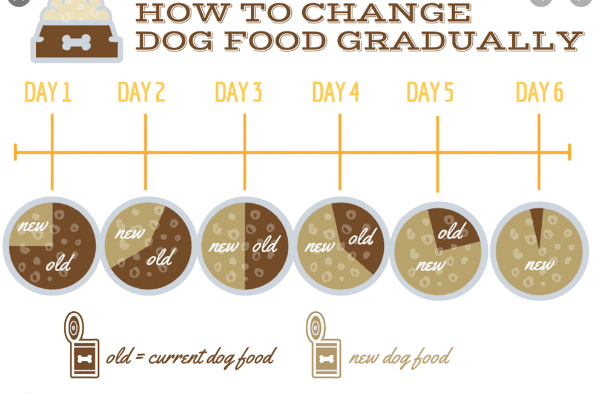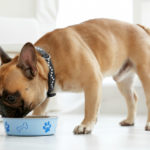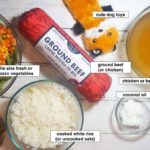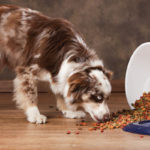How to transition dog food – Transitioning your dog’s diet simply means to change their current diet to a newer diet. Changing their diet could mean transitioning between food types, changing the particular dog food brand they are fed, or placing them on an entirely new recommended diet.
However, changing dog’s diet is not always so simple and uncomplicated as it sounds. On the side of the pet owner, it takes a lot of careful planning, trials, and recommendations from veterinarians. There are several reasons that can make a dog parent change their pets’ diet. Some of these reasons are often not as serious as the rest and may include:
- Variety sake (food variety)
- Switching brands
- To meet a nutritional goal
- New pet
On the other hand, the reasons for changing your hound’s diet may seem serious and entirely out of the owner’s hands. These reason can include:
- Health concerns (weight loss or gain) or diseases
- Changing to a veterinarian-recommended diet
- New stage nutrition
- Food allergies or insensitivities
- Getting neutered or spayed
Whether your reason for changing your dog’s diet is serious (like tackling a health-related or life-threatening issue) or just to spice things up, getting recommendations from veterinarians will always be the standard but not necessarily the only step to take. You can simply read the dog food label to see the contained ingredients and their proportions as long as you have enough knowledge about dog health and nutrition. In addition, dog food brands with complete or balanced tags on their cans or packs are often ideal choices.
The above mentioned reasons for transitioning or changing your dog’s diet will be discussed in detail
- Variety Sake (Food Variety)
Every day, thousands of dog foods find their way to the shelves of different pet food stores. Most of these new and recent products come in different forms: dry, semi-moist, wet, raw, and home-cooked, and often contain superior ingredients and more nourishing nutrients. A dog owner would likely transition to a new dog food brand that is more balanced and complete, is made with wholesome products, and contains nutrients in higher proportions that meet the dietary requirements of their dogs.
For instance, dog parents would likely transition to dog food brands with limited ingredients and novel proteins because of the value they offer and their dense nutrients composition. Such a transition can also involve combining complementary food types with complete ones, either as side-pieces or toppers.
Also, transitioning between diets can include trying to spice up things for your hound’s palate, especially if your hound is a picky eater. It can also mean alternating between the different forms of a particular chosen brand, like mixing the dry variant of a product with wet variant or mixing the raw dog recipe with dry food of the same brand. This might be an attempt to tackle the issue of dehydration or to balance out the remitted nutrients from both food types.
Transitioning for variety sake can also involve trying out several dog food brands until you find the perfect one for your dog. This is helpful especially when you are looking for the best (in terms of quality) and most economic dog food brand.
- Switching Brands
Switching brands is almost the same as transitioning for variety sake. Here, the switch is from one brand to the other, often a newer brand with a higher quality, denser nutrients concentration and probably more affordable than the latter. Also, it can mean switching from a brand because of a couple of reasons like, discontinued production and unavailability, and sudden development of allergic responses from your dog.
- New Pet
When a new pet is brought home from the shelter or dog home, a dog parent would likely want to change their diet to a newer more balanced diet containing all the right nutrients. However, this can have both good and bad consequences. It could be beneficial to the dog especially if they are malnourished or have a history of poor nutrition from their former home.
On the other hand, transitioning a dog’s diet without proper knowledge of their nutrition history could be dangerous. It is advised that a dog owner consults a veterinary doctor before changing their hound’s diet. It is advised that every dog owner of a new pet consults a veterinary doctor before attempting to change their diet. With due physical examination and subsequent recommendations, a feeding pattern, dietary requirements and known food choices would provide the knowledge needed to change the new dog’s diet.
Even without visiting a veterinarian, a dog owner could wait awhile and allow the dog ample time to adjust to its new environment while feeding them a single recipe or a mix of the various food forms so as to establish a pattern of desirability. During this period, the dog parent could learn a bit about what their dog likes and eats, and what it does not.
- To Meet A Nutritional Goal
Changes in nutritional goals can also lead to changes in diet. For every dog owner, there are certain dietary goals that they set for their canine companions and nudge them towards achieving them. Most of these goals are influenced by the desire to ensure longer and healthier lives for their pets. A pet parent may want leaner and stronger muscles for their pet dog and would then introduce foods with more fat and protein content, and less of calories. Also, some dog owners can want their dog to look bigger and more menacing and would likely give them foods with higher levels of calories to achieve that.
In addition, a dog’s diet could also change with a decrease or increase in their physical activity. For performance or working dogs in particular, their diets can change depending on how much energy is spent and how much is needed. For instance, most working dogs as they get older are introduced to foods with less fats and protein. This because of the awareness of their decreased physical activity and slower rate of metabolism. In the same vein, nutrients like vitamins, omega 3 and 6 fatty acids, and minerals will be included for repair and maintenance functions.
- Health Concerns (Weight Loss Or Gain)
While addressing the problem of weight loss or weight gain in dogs, diet transitioning is often regarded as an effective way to tackle both problems. Since weight loss or gain can be determined by various factors like life stage, level of physical activity, and getting neutered or spayed, changing diet to address such factors is often advised instead of attempting to tackle the weight loss or gain itself.
However, for dogs that are just obese the magic is to simply switch their diets. Transitioning to a weight loss diet or food with lower levels of calories and higher levels of protein and fats is recommended. Also, foods containing limited ingredients and more dietary fibers are effective in tackling weight gain. Furthermore, foods with lower conversion rates could be incorporated into their main diet.
This could also be combined with increased physical activities daily. It is important to note that to reduce their food rations would not help as it could lead to other food deficiencies because of the reduced amount of other necessary nutrients contained in the diet. The best bet here is to simple change their diet to a weight loss diet that has less fattening but still balanced and nutritious attributes. To be safe, it is advised that dog owners go for specially formulated weight loss diets instead of combing the pet food section and looking through hundreds of products.
On the other hand, dogs that are underweight are often placed on diets with higher levels of calories. The pet owner might introduce free feeding and dog treats too. For picky eaters, the diet can transition to newer more palatable and physically appealing recipes so as to entice the dog to eat.
On the other hand, obesity can come with related disease like diabetes, kidney diseases, arthritis, cancer, etc. it is essential to point out that a dog’s diet can change when it is diagnosed of certain diseases. This involves using the new diet to control the identified disease or manage the diagnosed deficiency. For dogs with chronic kidney diseases, diet transitioning and balanced nutrition is the surest way to manage the disease. Their diet can completely change to include foods with lower dietary protein but enough amino acids to avoid food deficiencies.
For dogs suffering from pancreatitis, their normal diet is changed to recipes that contain low fat. For some dogs, such low fat diets are for life. While for others, they can transition back to their normal diet once the threat is over.
In addition, dogs with colitis are often kept on diets that completely manage the situation seeing that it cannot be cured. To manage this disease, affected dogs are to be fed only recipes that contain novel protein, dietary fibers, and fats.
- Changing To A Veterinarian-Recommended Diet
Sometimes a veterinarian doctor may recommend therapeutic or prescription diet for dogs and such recommendation can warrant to a diet change. This diet change is often with the intention of tackling a health issue, certain reactions to food, or problems based on specific dietary needs. Such recommendation is usually necessary when dealing with issues like skin and coat state, lack of appetite, breed-based deficiencies, bone, teeth and joint health, hair loss, level of activity, and oral needs. Some veterinarian recommended diets can be breed-specific and include: low sodium, low protein, high protein, low calories, limited ingredients, organic, low fat, holistic diet, etc.
- New Life Stage Nutrition
It is an established fact that dogs just like humans have constantly evolving dietary needs especially as they grow and age. For example, a recently weaned puppy changes from breast milk to its first puppy-formulated formula (either dry, wet, or both), and would require nutrients that would promote the growth of strong bones and teeth, healthy and luscious fur, aid brain and vision development, and improve the quality of egested stool. As such, core nutrients like protein, fats, vitamins, carbohydrates, minerals, and the rest are needed in varying proportions.
Also, this same puppy (from 9 to 24 months depending on size, sex and breed) will likely change to a more advanced diet comprising more of protein, fats, vitamins and minerals to support his constantly changing biological functions as he ages. Likewise a pregnant mother or lactating mother, who needs a set of nutrients to nourish both her and her growing pups. This same diet is bound to change once she gives birth, starts breastfeeding, and even after breastfeeding. While for adult dogs, their diet changes (depending on breed) the more they grow and mature. Their diet can further change depending on their dietary requirements and their level on expended nutrients.
In addition, senior dogs would require a diet transitioning as they get older, especially as they experience some health issues associated with old age. As dogs age, they often tend to experience bone and joint issues, kidney problems, diabetes, and heart issues, along with overweight problems due to their reduced physical activity. And as expected, their new diet is supposed to comprise of nutrients that alleviate these problems.
For instance, most food formulas for senior dogs contain substances like chondroitin and glucosamine, both of which improve bone and joint health. Also, they require less of fats and proteins, and more of vitamins and minerals. This change of diet at every point is necessary as the new diet is believed to supply dogs with the bulk of nutrients required at each particular stage.
This is really why most dog brands have dog food formulas for each life stage. These stage-specific formulas are packed with the needed nutrients and make transitioning easier for dog parents. Some of these stage-specific formulas include:
For puppies- Wag Dry Food for Puppies, IAMS proactive healthy puppy dry food, purina pro plan focus puppy large breed formula dry dog food, Royal Canin small puppy dry dog food, farmina N&D ancestral chicken and pomegranate recipe mini puppy dry dog food, etc.
For adult dogs-blue buffalo wilderness high protein adult dry food, purina beyond natural dry dog food, Amazon Wag salmon and lentil recipe, etc.
For senior dogs- Wellness core senior dog food, Orijen senior dog food, pro plan bright mind adult 7+ senior chicken and rice, Go! Carnivore senior formula, etc.
- Food Allergies And Insensitive Stomach
Food allergy or hypersensitivity is big enough a reason to completely change your furry partner’s diet. Food allergies and intolerances are believed to be caused by the presence of certain allergens in dog foods. Your dog can react adversely to certain food sources not minding the fact that they have been eating them for years. Once your dog is diagnosed to be having an allergenic reaction, it is advised that the dog’s diet be completely changed or switched.
Symptoms of food allergies and insensitivity include: licking paws, diarrhoea, hair loss, vomiting, and skin irritation. To tackle food allergies or food hypersensitivity related to food, it is recommended that the hound’s normal diet changes to hypoallergenic diets.
Also, elimination recipes with novel protein sources (like bison, kangaroo, venison, rabbit, etc) and a singular carbohydrate source or non-allergenic recipes with limited ingredients can take over the dog’s normal diet. It is advised that dog owners consult a veterinarian or a vet dermatologist before transitioning their dog’s diet. However, it is important to establish the fact that food allergy and food intolerance are not the same thing.
- Getting Neutered Or Spayed
Even though there are many benefits to castrating dogs and spaying dogs, the aftermath weight gain is often not discussed enough. Neutering and spaying procedures both lead to weight gain twice what is experienced with dogs that are sexually active. This is because both procedure can cause decreased physical activities and energy use and intermittently alter feeding habits. Once these happen, obesity is never far away.
For dogs who have undergone neutering and spaying, they have lower calories needs. Thus, it is very important to switch their diet to an entirely new diet that recognizes their changed dietary needs and the prevalent nutritional issues. For most dogs, it is crucial to change their normal diet to specially made diets and formulas for neutered or spayed dogs.
Transitioning Your Dog’s Diet
While transitioning your dog’s diet, it is very necessary that dog owners do everything right. Furthermore, it is advised that diet switching be gradual and well-planned so as to avoid gastrointestinal upsets, diarrhoea, and other troubles related to digestion. To help with the diet change, a detailed diet schedule can come in handy. This schedule should contain the number of days the switch is intended to last and the different proportions of both the old and new food for the numbers of days in the transition schedule. The 7-day transition schedule is often the easiest and most commonly adopted model. However, this transition schedule is not the ideal but only the generally accepted one. For dogs with sensitive stomach and digestive diseases, the transition method could take a longer time.
This transition schedule includes a gradual incorporation of the new diet to the old one and could often a framework like this:

- DAY ONE-25% new diet versus 75% old diet
- DAY TWO- 30% new diet versus 70% old diet
- DAY THREE-40% new diet versus 60% old diet
- DAY FOUR-50% new diet versus 50% old diet
- DAY FIVE-60% new diet versus 40% old diet
- DAY SIX-75% new diet versus 25% old diet
- DAY SEVEN-100% new diet
During the period of diet transition, it is essential to supervise the dog’s reaction of the new diet especially for dogs with sensitive stomachs. Their reaction to the transition should determine the pace of the transitioning. If they are adversely affected by the new diet, the wise thing will be to slow things down and extend the transitioning to 10 to 12 days or keep the ratio of old versus new diet constant for a few day and see if it improves things. And if this problem persists, it is advised that the dog owner consults a veterinary doctor.
When switching to a superior food brand, especially one with a denser nutritional concentration, dog parents need to make sure the ration given to the dog tallies with the transition percentage of the day. Understanding this is necessary so as to avoid gastrointestinal complications or obesity. To get the right quantity, a measuring cup can be used. Also, following the recommended feeding guideline on the product pack can help with getting the accurate measurement. Getting the right amount is as important as getting the right transition schedule.
Types Of Diet Transitioning (Based On Food Type)
Even though transitioning gradually is the recommended way, certain factors can necessitate a faster switching from old to new diet depending on the reason for changing diet. For instance, if the old food is making your dog sick switching the cold turkey method seems unavoidable. Also, when the old diet is limited or not available, a new diet can be introduced with no trace of the old diet.
The Cold Turkey Switch
Switching cold turkey is a transition method often adopted when switching to entirely new food types, instead of switching between brands within the same food category. This method may involve transitioning from a grain kibble to raw meat, or from grain kibble to grain-free kibble immediately without a schedule. While this may cause serious gastrointestinal problems, many believe that fasting the dog for at least 12 hours before feeding them their first raw diet helps to overcome the lapse. This method of transitioning does not encourage mixing two different meals types. For example, mixing dry dog foods with raw dog food is never advised. This is because such mixture may lead to stomach upsets seeing that both meals have varying patterns of digestion and absorption. While bones and other raw food items are digested almost immediately, kibble dog food takes 12 to 24 hours to digest.
The key to making this transition method work is introducing more of real red meat and bone, usually from one animal source, and less of meat organs. The meat should be easily-digested and have enough flesh and bones. However, this method of switching can be difficult, especially with dogs that have been fed with kibble for years. The only thing to do here is to consult a veterinarian and allow the dog adjust to the new diet.
Gradual Transitioning
While there are dogs that may far better with immediate or cold turkey diet switching, others would not and this is not always because they have sensitive stomachs. Gradual diet transitioning is the ideal and mostly recommended method while switching a dog’s diet, regardless of the type of diet. Rushing the transition can cause stomach distress and gastrointestinal upset, with the more obvious symptoms being diarrhoea and vomiting.
While switching diets, be sure to closely monitor your dog’s general response to the newly introduced diet. A smooth transition can be achieved by taking note of these factors
- Stool quality-checking the stool quality of your dog while switching diet is very important. This is because this excreted matter is the surest way to ascertain what is going on within their digestive system. When the stool is runny or watery, it could mean that they are having digestive problems. If this condition continues then it is necessary to consult your veterinary doctor. In addition to stool consistency, the colour should also be noted. To get an accurate analysis, a fecal scoring chart can be adopted. With the fecal chart, a lower number suggests digestive problems like constipation or dehydration while a higher number shows gastrointestinal troubles.
- Maintaining hydration level-keeping the dog constantly hydrated is another important part of diet switching. This is because constant hydration can ease digestive stress and promote quicker absorption.
During diet transition dogs may have adverse reactions which result to epidermal and gastrointestinal symptoms. Some of these symptoms may include: vomiting, skin itch, nausea, hair loss and inflammation, chronic gas, lack of appetite, constipation, and diarrhoea. When these symptoms start to occur, it is important to visit a veterinarian for proper evaluation. Once it is established that your hound has a food allergy, the veterinarian may suggest a couple of corrective measures like skin cultures, blood trials and elimination tests.
Some Transitioning Tips

Detailed planning: when switching your dog’s diet, you need to have a well detailed plan ahead of the transition period. You need to make sure the new diet is available and sufficient to last throughout the transition period. Also, counter plans should be made for emergencies that may disrupt the schedule like unplanned travelling, camping plans and other situations that may warrant hiring a dog sitter to take care of your hound while you are away.
Use digestive aids: to ensure proper adjustment and seamless digestion, digestive aids can be introduced especially when switching cold turkey. Soluble fibers like pumpkin, antibiotics and probiotics can help alleviate the upset in the digestive tract. It is necessary to make sure that the chosen digestive aids are veterinarian-recommended.
Choose the right dog food: choosing the right dog food is as important as everything during transitioning. To overcome the confusion of picking the right dog food from a hundreds of choices as the pet food store, you can check out reviews of dog foods online from reliable sources. In addition, simply reading the food label can prove sufficient if you have a little knowledge about dog nutrition. You can also check out dog food brands that are recognized by AAFCO and come with descriptions like “100% organic” and “complete and balanced”.
Proper evaluation and close observation: closely observing and evaluating your dog’s response to the new diet is extremely important. In addition to adhering to recommended advice from your vet, you also need to monitor the general state of your hound within this period. Constantly check their weight to know if they are losing or gaining weight, and their cutaneous reaction to the new diet. Also monitor their behaviour during transition as it would help ascertain if the new diet agrees with their system or not.
When the dog refuses to eat-some picky eaters may refuse to eat the newly-introduced meals but this should not make you panic. Introducing wet food brands or foods with raw flavours can help stimulate the hound’s appetite and encourage consumption. While for kibble pieces, rehydrating with hot water and adding flavour enhancers like common salt, maltol, amino acids, monosodium glutamate, etc can spike palatability and restore appetite. Also, introducing dog treats at this stage should be done with extra care. This is because feeding them dog treats might get the stuck on the treats and lead to sustained loss of interest in the new diet. Instead coated and flavoured kibble brands can be used to substitute for dog treats.
Constantly consult your veterinarian– during this sensitive period, your veterinarian is your best resource-point and should be on speed dial. It is advised you consult your veterinary doctor for issues like food allergies and intolerances, feeding rations and guidelines, nutrients amount and intake, and all nutrition-related complications. Also, when the vet recommends a therapeutic or prescription diet it is required that all rules and suggestions are strictly adhered to.
Complications: while transitioning, complications are likely to arise. When this happens, you can slow down and adopt an extended transitioning schedule in order to allow your dog adjust to the new diet. Remember that food allergies cannot be cured, but sampling a variety of diets or completely eliminating the causative allergens can help.
Follow through patiently: transitioning diet for your dog can be a daunting and overwhelming experience. The best thing to help you achieve what you want is to be patient. It is totally normal for your dog to develop side-effects to the new diet and also normal for the side-effects to persist even after adopting some preventive measures. The key thing is to allow you dog adjust to a pattern before proceeding with the whole transition.
Some Allergens To Avoid While Switching Your Dog’s Diet
Food allergies occur when the digestive system is unable to digest and absorb eaten protein sources in order to release the nutrients they contain. When this happens, the body assumes that these undigested protein pieces are diseases and treats them as such. There are a couple of food items that are known to upset the balance of the digestive system and they include:
- Diary product and by-products
- Beef
- Eggs
- Wheat
- Rice
- Corn
- Pork
- Chicken
- Soy
- Rabbit
- Fish











